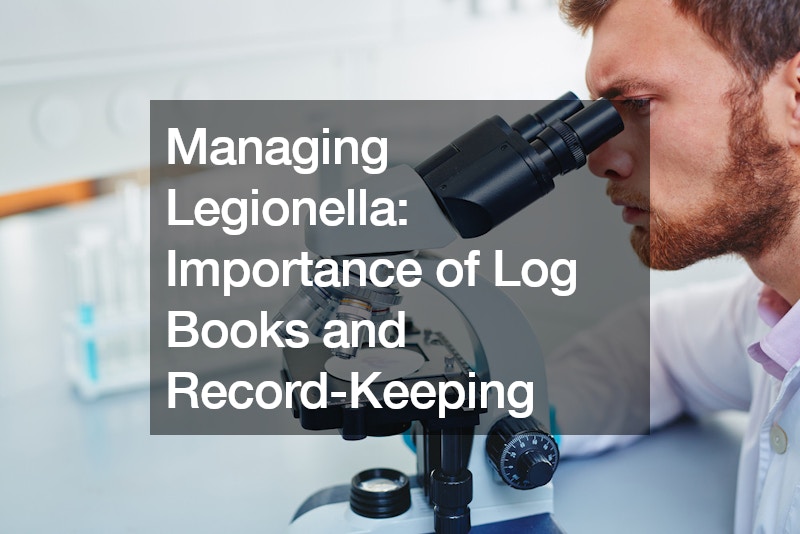

Legionella is a type of bacteria that can cause Legionnaires’ disease, a serious form of pneumonia. It thrives in warm, stagnant water and can be found in man-made water systems like cooling towers, domestic hot and cold water systems, and whirlpool baths. While the risk of Legionnaires’ disease is relatively low for healthy individuals, it can be severe and even fatal for those with compromised immune systems or underlying health conditions.
Property owners and managers have a legal responsibility to control the risk of Legionnaires’ disease by implementing a robust risk management plan. This plan should include a legionella risk assessment, a written scheme of control, and, most importantly, meticulous legionella log book and record-keeping practices.
Why are Legionella Log Books and Record-Keeping Important?
Legionella log books and record-keeping are crucial elements for demonstrating compliance with regulations and ensuring the safety of building occupants. Here’s why:
Evidence of Due Diligence: Legionella log books and records provide documented proof that a property owner or manager has taken appropriate steps to identify, assess, and control the risk of Legionella growth. This documentation can be invaluable in an outbreak or an audit by health and safety authorities. Monitoring and Control Measures: Legionella logbooks record vital information about the monitoring and control measures implemented within a water system. This includes temperatures, disinfection procedures, cleaning schedules, and any corrective actions taken. Regularly reviewing these records allows for early identification of potential problems and timely corrective actions. Improved Communication and Accountability: A well-maintained legionella log book fosters clear communication between responsible personnel. It ensures that everyone involved in the management of the water system is aware of their roles and responsibilities related to Legionella control. Additionally, detailed records promote accountability and ensure tasks are completed consistently and effectively. Trend Analysis and Continuous Improvement: Legionella logbooks offer historical monitoring data and control measures records. By analyzing trends over time, responsible parties can identify areas for improvement and refine their risk management plan to address any weaknesses proactively. What Should Be Included in a Legionella Log Book and Record-Keeping System?
The specific content of a legionella log book and record-keeping system may vary depending on the size and complexity of the water system. However, some key elements should be consistently documented:
Management Responsibility Structure: The logbook should identify the individuals responsible for implementing and overseeing the legionella control measures. This includes the duty holder (property owner or manager) and any appointed competent person responsible for the day-to-day tasks. Legionnaires’ Disease Risk Assessment: A copy of the most recent legionnaires’ disease risk assessment should be readily available within the record-keeping system. The risk assessment should identify potential hazards within the water system and outline the control measures needed to mitigate those risks. Written Scheme of Control: The written scheme of control details the specific measures to be taken to control the risk of Legionella growth. This document should be incorporated into the record-keeping system and readily accessible for reference. Schematic Drawings of Water Systems: Including detailed schematic drawings of the water system within the records can be highly beneficial. These drawings should illustrate the system’s layout, including pipework, tanks, and other components, allowing for a clearer understanding of potential risk areas. Monitoring Records: Detailed records of all monitoring activities, including temperature readings, disinfection procedures, and cleaning schedules, should be meticulously documented in the logbook. These records should include dates, times, and the name of the individual conducting the monitoring tasks. Maintenance Records: Records of all maintenance activities performed on the water system, including equipment servicing, repairs, and replacement of components, should be kept within the system. These records should detail the nature of the work performed, the date it was completed, and the service provider’s name. Audit and Review Data: Regular audits and reviews of the legionella control measures should be conducted to ensure continued effectiveness. The results of these audits and any corrective actions taken should be documented within the record-keeping system. Training Records: Maintaining records of training received by personnel managing the water system demonstrates competence and awareness of Legionella control procedures. These records should include the type of training provided, the date it was delivered, and the names of the attendees. Maintaining a Legionella Log Book & Record Keeping System
Several key practices ensure the effectiveness of a legionella log book and record-keeping system:
Accessibility: The log book and records should be readily accessible and stored in a secure location where authorized personnel can easily retrieve them during inspections or audits.
Accuracy and Completeness: All entries in the log book and records should be accurate, complete, and recorded promptly. Any errors or omissions should be corrected with clear annotations indicating the date and reason for the change.
Retention Period: Legionella log books and records should be retained for a minimum period as local regulations mandate. In some jurisdictions, this period can be as long as five years.
Electronic vs. Paper Records: While traditional paper log books have been used for legionella control, electronic record-keeping systems are becoming increasingly popular. These systems offer improved accessibility, searchability, and data analysis capabilities. However, regardless of the format chosen, ensuring the integrity and security of the records is paramount.
Conclusion
Legionella control is a crucial responsibility for property owners and managers. Implementing a robust risk management plan that includes a comprehensive legionella log book and record-keeping system is essential for demonstrating compliance with regulations, protecting building occupants, and minimizing the risk of Legionnaires’ disease outbreaks. By maintaining accurate and detailed records, property managers can proactively manage their water systems, identify potential problems early, and ensure the health and safety of everyone within the building.
.



